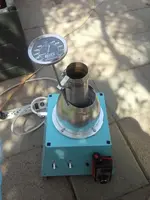CucamongaDan
New member
- Jan 22, 2018
- 37
- 0
Hi everyone! As I just said in the introductions thread, I've been home roasting for about three years. I'm the only coffee drinker at my house, so I roast about a pound a week (in 1/4 pound batches because I like variety). I do give some away to a few people too.
I started with a air pop popcorn maker, and after collecting a few I began tinkering with them after reading how they ought to be modifed to give better control of the roast.
This is the current incarnation of what I've been using for almost two years now.

Inside the blue box is the heating coil assembly from a 1200 watt popcorn pumper. I put each heating coil on its own circuit and can switch them on and off as needed. Usually I run them both but might switch the smaller one off as the roast is getting into the cracks so I don't get too hot and scorch it. Then when its done I switch them both off and keep the air running until it has quickly cooled down to about 100 F before I dump it onto a cookie sheet for final cooling and to check for defective beans. I mainly use the air flow rate to control the speed of the roast. I removed the original fan and its motor and in place of that fan motor is the nozzle from an electric air pump- the kind used to inflate air mattresses.it is plugged into the router speed control you can get from Harbor Freight Tools.
I average about 8 minutes to first crack and go to cooling about 2 or 3 minutes after that. I like light to medium roasts and when I'm shopping for green beans I tend to get ones that take well to lighter roast levels. I like almost all the coffee varieties I've tried to roast.
Looking forward to talking to some fellow roasters and lover of good, fresh coffee.
I started with a air pop popcorn maker, and after collecting a few I began tinkering with them after reading how they ought to be modifed to give better control of the roast.
This is the current incarnation of what I've been using for almost two years now.

Inside the blue box is the heating coil assembly from a 1200 watt popcorn pumper. I put each heating coil on its own circuit and can switch them on and off as needed. Usually I run them both but might switch the smaller one off as the roast is getting into the cracks so I don't get too hot and scorch it. Then when its done I switch them both off and keep the air running until it has quickly cooled down to about 100 F before I dump it onto a cookie sheet for final cooling and to check for defective beans. I mainly use the air flow rate to control the speed of the roast. I removed the original fan and its motor and in place of that fan motor is the nozzle from an electric air pump- the kind used to inflate air mattresses.it is plugged into the router speed control you can get from Harbor Freight Tools.
I average about 8 minutes to first crack and go to cooling about 2 or 3 minutes after that. I like light to medium roasts and when I'm shopping for green beans I tend to get ones that take well to lighter roast levels. I like almost all the coffee varieties I've tried to roast.
Looking forward to talking to some fellow roasters and lover of good, fresh coffee.
